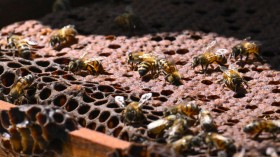Polluted waters in New Bedford Harbor in Massachusetts have proven a challenge to decontaminate, but the water, laced with heavy metals and PCBs from decades of factory runoff, is also puzzling because a Atlantic killifish are not only tolerating the toxic conditions, they seem to be thriving in them.
New research published in journal BMC Evolutionary Biology details how the Atlantic killifish - small non-migratory fishes common in the 18,000-acre New Bedford Harbor estuary - have evolved a genetic resistance to polychlorinated biphenyls (PCBs).
The research, led by scientists at Woods Hole Oceanographic Institution (WHOI), centers around a receptor protein, called the aryl hydrocarbon receptor 2 (AHR2).
"Normally when fish are exposed to harmful chemicals, the body steps up production of enzymes that break down the pollutants, a process controlled by the AHR2 protein. Some of the PCBs are not broken down in this way, and their continued stimulation of AHR2 disrupts cellular functions, leading to toxicity," WHOI reported in a news release. "In the New Bedford Harbor killifish, the AHR2 system has become resistant to this effect."
Mark Hahn, a biologist at WHOI and coauthor of the research paper, said the Atlantic killifish have managed to shut down the genetic pathway that leads to PCB poising.
"It's an example of how some populations are able to adapt to changes in their environment -- a snapshot of evolution at work," he said.
To test their finding, Hahn and his colleagues from Atlantic Ecology Division of the US Environmental Protection Agency, the Boston University School of Public Health, and the University of North Carolina at Charlotte, sequenced the protein-coding portion of three candidate resistance genes in fish from the New Bedford site and six other locations, both clean and polluted, along the northeast coast, WHOI reports.
The researchers found subtle variations in the DNA sequence in AHR2 among the fish across different sites, which they suggest play a role in mediating toxicity in early life stages. The function of the AHR2 receptor mediates toxic effects. The New Bedford Harbor killifish were found to not have functional AHR2 receptors, which lowered their susceptibility to the toxic effects of the pollutants in the water.
WHOI reported that the researchers found the AHR2 protein in killifish has 951 amino acids and nine of those vary among individuals. The different combinations of amino acid variants lead to 26 different forms of the protein
"We see that the pattern of variants present in the New Bedford Harbor killifish is much different from the patterns at nearby sites, which is unexpected under normal circumstances," Hahn said. "There are a few protein variants that are common in New Bedford Harbor killifish, but uncommon elsewhere. Similarly, the protein variants that are most common at the nearby reference sites are much less common in the New Bedford Harbor killifish."
Atlantic killifish are essentially thriving in New Bedford Harbor today, but the site is one of the EPA's largest Superfund cleanup sites, and the toxic conditions of the water might not always be there.
"Obviously, the fact that they are resistant to PCBs allows them to survive in this really polluted environment, but what will happen once the harbor gets cleaned up? There could be costs that make it no longer adaptive for these fish to live there," Hahn said.
"It's a fascinating example of how human activities can drive evolution," he added. "The ability to adapt to changing conditions is going to become even more important as humans impact the environment, whether it's from ocean acidification or increasing temperatures or other types of global changes that are occurring."
© 2024 NatureWorldNews.com All rights reserved. Do not reproduce without permission.





